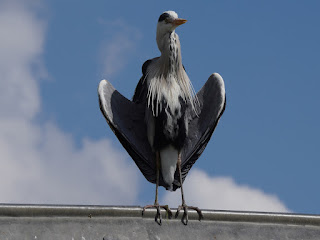The young Grey Heron from the second nest perched on the handrail of the stairs at the bridge. This place belongs to an older heron which saw it flying in and hurried to attack it. The younger heron lost and had to go down to a less interesting place on the path below.
More peacefully, a heron sunbathed on the roof of a boathouse.
Another was fishing under the marble fountain on the edge of the Italian Garden (though you wouldn't know it was fine Carrara marble under all the algae, something the sculptor hadn't bargained for).
A view across the garden, with Portland stone ram-headed urns along the balustrade. The male Egyptian Goose idled on an urn. His mate is nesting an a tree nearby.
The four younger Egyptian goslings were under the bridge. One hurried to catch up with the others.
But they aren't the youngest any more. A pair on the north shore of the Serpentine have brought out ten new goslings.
A Greylag Goose ate the potted plants at the Dell restaurant. It liked an ornamental red sedge, Carex punicea, which is a native of New Zealand.
The Black Swan was at the other end of the restaurant terrace, alone and looking melancholy. It seems that he doesn't know about St James's Park, just five minutes away by air, where he would have the company of his own kind including an unattached female who might be pleased to see him.
A Coot enjoyed a wash and a preen and a scratch.
The single Great Crested Grebe chick on the Long Water was also preening, in the intervals of pestering its parents.
A few Swifts hunted over the Round Pond.
The male Little Owl was in exactly the same place as yesterday. The owlets in the dead tree could be heard hissing faintly.
While I was looking unsuccessfully for an owl at the Serpentine Gallery the usual male Chaffinch arrived and landed on the wood chips under the old chestnut tree.
A Starling in the Flower Walk shone in the sunlight.
A female Black-Tailed Skimmer dragonfly rested on a sisyrhynchium in the Rose Garden.
A Common Carder bee worked over a patch of red clover behind the Lido ...
... and the eryngium clump, now in full spiky flower, was busy with Honeybees.














Hi Ralph, well I asked about Egyptian goslings, you certainly have them in abundance now !!......I love the pic of the skimmer dragonfly.one of your best insect pics, if I may say so...any news of whether anyone (Jenna ET AL) are still doing nightly patrols to find the swines who were letting dogs off the leads at the swans ?...I am very impressed with the swift pics, I can't get any decent pics of moving birds....(Even on "sport" setting)..is it shutter speed ?regards, Stephen..
ReplyDeleteThe dog owner has been visited by the police. So some progress has been made.
ReplyDelete'Sports setting' on an ordinary camera is not all that fast, usually 1/500 second. For swifts you need at least 1/1000; that picture was taken at 1/1250. For dragonflies in flight you need 1/2500. Does your camera have a mode where you can set shutter speed? Usually called S.
Hi Ralph, I will have a look for that setting.
ReplyDeletegood news RE. The dog "owner"...regards,Stephen...
Yes it does have a "S" setting. Will try in the morning..Thanks,regards,Stephen.....
ReplyDeleteThe Black Swan's situation is symbolic of human life at almost all levels.
ReplyDeleteI'd ordinarily say, what a waste of Carrara marble to have it covered with algae. But the effect is very pleasing, I think. Organic, lived-in, alive.
Tinúviel
Yes, it's not every sculpture that supplies food for Moorhens. I'm slightly puzzled by the amount of algae, though. The fountain takes water direct from a lifeless borehole at the steady underground temperature of 10°C and distributes it to the lake. (The fountains inside the garden are closed recirculating sytems, so algae are to be expected.)
Delete